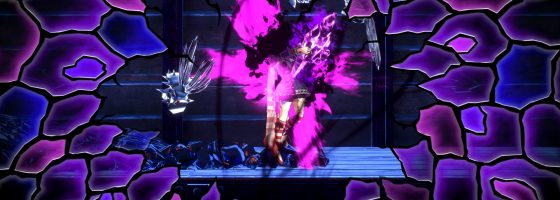Bloodstained Ritual of the Night had a lot of excitement around it. A new Metroidvania helmed by Koji Igarashi: the assistant director behind Castlevania Symphony of the Night and the person who became synonymous with its success. With the game finally out, it is true that we have a brand new Metroidvania to look at, with all the highs and lows that it entails.
Igavania:
Bloodstained has been dubbed by fans and the studio as the next “Igavania,” which is just a playful way of defining a take on “Metroidvania” design. The term Metroidvania refers to games where the player is free to explore an environment but is oftentimes hampered by needing specific upgrades and powers that unlock new moves or abilities.
The Igavania part of things refers to having a loose RPG system on top of the action-based gameplay. You are free to equip your characters with weapons and gear. Every weapon belongs to a different category and there are special techniques you can learn for each one.
The gear variety is very well done in Bloodstained, and the game opens things up to allow you to make use of any of them; including shoes, a parasol, and more. The real meat of customization is the shard system, and where a lot of the farming comes in.
Crystal Crashers
Starting from Dawn of Sorrow, the Castlevania games introduced the ability for the player to equip the souls of their enemies as special moves. Bloodstained continues that trend with the enemies sometimes dropping shards that main character Miriam can equip. The shards belong to one of five categories, and you are limited to one shard equipped per category.
Every enemy in the game can drop a shard and your choices will quickly balloon over the course of playing. From summoning paintings, throwing bats at people, and many more options will be available. Some shards allow you to summon familiars to help, and others provide a passive bonus.
For players who really want to dig into the game’s systems, the combination of gear and shard use will keep you occupied for some time. The farming comes in with the game’s crafting/upgrading system.
Shards can be improved by finding copies and using resources to upgrade their rank. As a shard goes up in rank, it may gain additional properties or functionality on top of just improving its utility. It’s going to take a lot of items and farming in order to enhance everything, as well as craft the best gear in the game.
From a mechanic and system standpoint, everything about Bloodstained works, but having played so many metroidvanias this decade, I can’t help but feel disappointed with some of the issues present.
A Trip to the Past
Bloodstained is very much a game designed around old school gameplay and UI, and that is a negative in this case. I found the menuing to be very cumbersome when it came to crafting and setting up the game to remember builds.
The crafting will oftentimes require you to look through multiple screens to find the information on what you want to craft, what’s needed, and where to get the materials from. I feel that this could have been done more streamlined by allowing players to mark what items they want to craft, and make that information stand out on the other screens.
When trying to set up build shortcuts, you can’t just press one button and have the game remember it, you must go through two screens to do it, and repeat it each time you make a slight deviation. This becomes more annoying the further you go due to having more movement-based shards unlocked that are used to get through specific obstacles.
The game also feels old in terms of setting up the challenges for the true ending. The requirements are very obtuse, and I can’t imagine many people figuring them out without resorting to an online guide.
Finally, after all the talk about the game receiving a graphical update, I still found it to be somewhat of a letdown in the aesthetics department. There was a clash between many of the enemy designs and backgrounds.
Some parts looked very well done, while others had a “plastic-like” look to them. The game just didn’t seem to have a unified look to it in the same way that contemporary takes on the genre has, like Hollow Knight or Dead Cells.
Measuring a Metroidvania
Again, mechanically speaking there is nothing wrong with Bloodstained Ritual of the Night. If you’re looking for a metroidvania game, then you are going to enjoy this. However, if you’ve played more modern examples of the design and were hoping for an elevated take, then Bloodstained may be a disappointment for you.
I’m going to be curious to see how things develop with the planned DLC, but the real question I have is if we’re going to see more metroidvania, or Igavanias, down the line from this studio. It has been 11 years since the last 2D metroidvania Castlevania was released. I hope that we see more and that the studio has a chance to grow the design as opposed to just reminding everyone about it.




